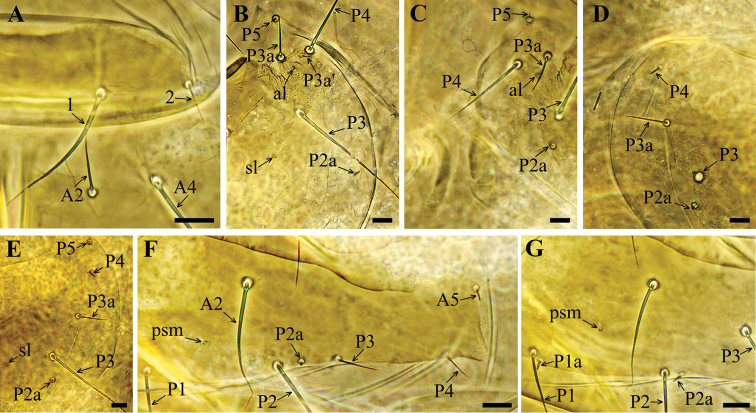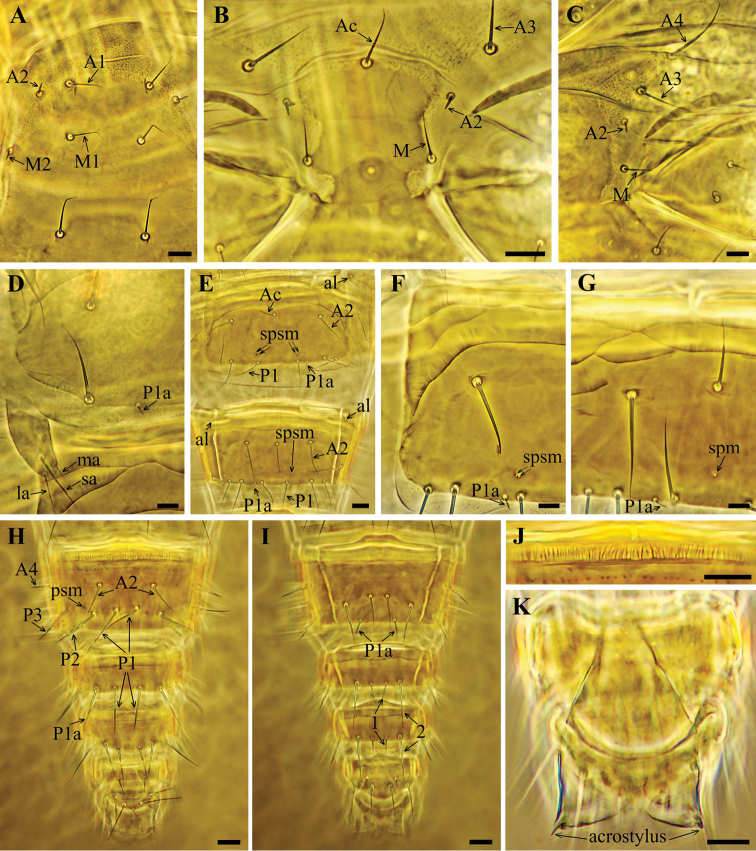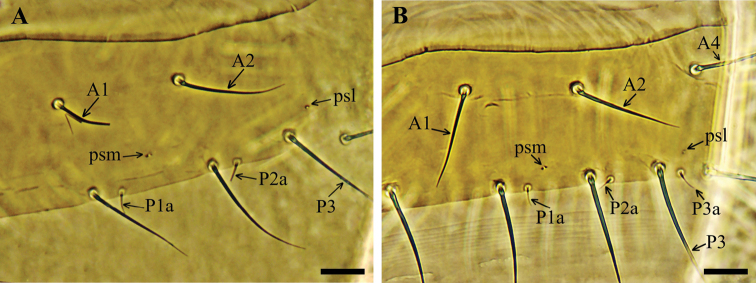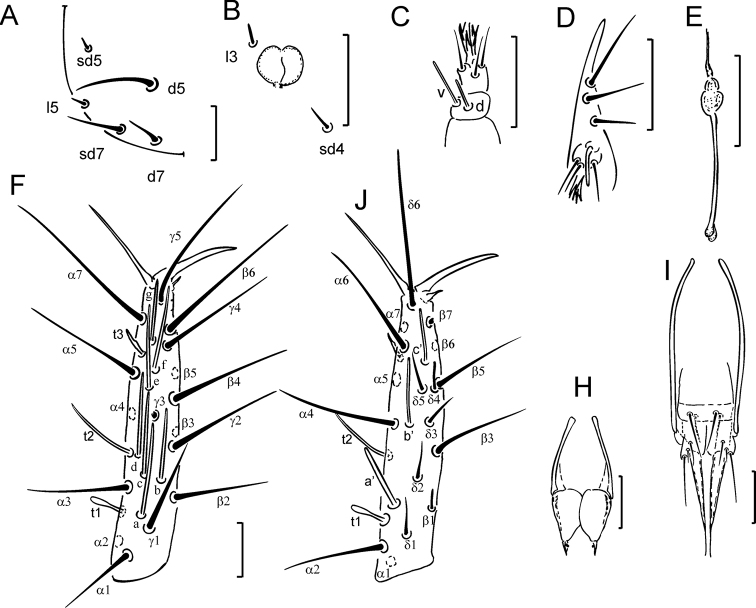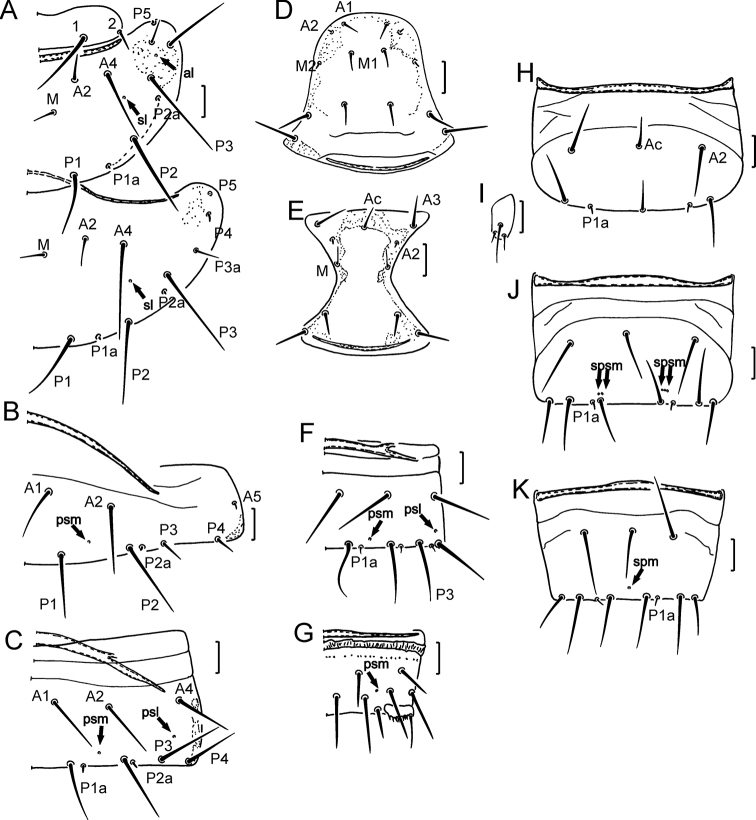Abstract Abstract
A new species, Acerentulus bulgaricussp. nov., belonging to the confinis group, is described from Bulgaria. This species is characterized by long foretarsal sensilla a and b, the posterior position of foretarsal seta δ4, the presence of seta P1a on abdominal tergites II–VII and seta P3a on abdominal tergite VII, possession of eight anterior setae on abdominal tergite VII and composed spsm pores on sternite VI. The new species differs from all members of the confinis group in possessing P1a setae on tergites II–VII. Otherwise it is similar in body chaetotaxy and porotaxy to three species of the cunhai group, A. proximus, A. correzeanus and A. tuxeni. The identification key to 22 Acerentulus species belonging to confinis group is revised.
Keywords: Chaetotaxy, Holarctic, identification key, porotaxy, proturans.
Introduction
The proturan genus Acerentulus Berlese, 1908 is widely distributed over the Holarctic, reaching Southern America, Australia and New Zealand. According to the Catalogue of the World Protura (Szeptycki 2007), the genus comprises 40 species and 2 subspecies. Acerentulus rapoporti Condé, 1963, which was noted by Szeptycki (2007) as “species incertae sedis”, was recently synonymized with Andinentulus ebbei (Tuxen, 1984) (Shrubovych et al. 2014a). Several species, noted as “species inquirendae” in Szeptycki (2007), are not placeable; type materials were lost for Acerentulus americanus Hilton, 1943 and A. shensiensis Chou & Yang, 1964, and A. aubertoti Condé, 1944 was described from a prelarva (see Tuxen 1955, Szeptycki 2007). Since Szeptycki (2007) additional species have been described, bringing the current total to 48 species (Wu and Yin 2007, Shrubovych et al. 2012, 2014b, Galli and Capurro 2013, Galli et al. 2017). Distributions and taxonomic differentiation between the 21 species within the confinis group was discussed previously (Shrubovych et al. 2012). The present paper contains a description of a new Acerentulus species from Bulgaria, which belongs to the confinis group. Only three species have been recorded from Bulgaria till now: Acerentulus confinis (Berlese, 1908), A. gisini Condé, 1952 and A. traegardhi Ionesco, 1937 (Szeptycki 2007) contrary to well-studied neighboring countries: 11 and 8 Acerentulus species were recorded in Serbia and in Romania respectively (Blesić and Mitrovski-Bogdanović 2012, Shrubovych and Fiera 2016). An identification key to the confinis group of species worldwide is updated and reorganized according to morphological characters.
Material and methods
Protura specimens, collected in Bulgaria from 2015 to 2018, were extracted from soil samples with Berlese-Tullgren funnels into 95% ethanol. All specimens were mounted on glass slides in Faure’s medium (Dunger and Fiedler 1989). Additional material was analyzed in the collection of J. Rusek, deposited in the Institute of Soil Biology, Biology Centre of the Czech Academy of Sciences (ISB).
The holotype and other materials of D. Georgiev and C. Fiera are deposited in the collection of the Institute of Systematics and Evolution of Animals, Krakow, Poland (ISEA). One female paratype (ISB A-791.1) and materials of J. Rusek are deposited in the collection of the Institute of Soil Biology, Biology Centre, Czech Academy of Sciences. One female paratype (SMNH 90.1) is deposited in the collection of the State Museum of Natural History, Lviv, Ukraine (SMNH).
The morphological characteristics of the genus are given in Nosek (1973), Imadaté (1988), Szeptycki (1991), and Galli et al. (2018). Some new details concerning development and variability of chaetotaxy and porotaxy are added. Information on the taxonomy of Acerentulus species was taken from original descriptions or redescriptions of type materials in Nosek (1973). For description of morphological characters, the terminology used by Rusek et al. (2012), Szeptycki (1991) and Shrubovych (2014) was followed for this study. Abbreviations used in the description are as follows: Abd. = abdominal segments, Th. = thoracic segments, al = anterolateral pore, sl = sublateral pore, psl = posterosublateral pore, psm = posterosubmedial pore, spm = sternal posteromedial pore, spsm = sternal posterosubmedial pore.
Results
Acerentulus bulgaricus
Shrubovych sp. nov.
92C9B965-8D70-5CF0-B58F-CB3E24D8C4C1
http://zoobank.org/28AA95C1-B361-4A22-9D4D-AE714690241D
Figs 1 , 2 , 3 , 4 , 5 , 6 ; Table 1
Figure 1.
Acerentulus bulgaricus sp. nov.: Holotype A habitus B lateral part of head C hind part of head D maxillary gland E maxillary palpus F labial palpus G–I exterior view of foretarsus. Scale bars: 100 µm (A), 10 µm (B–I).
Figure 2.
Acerentulus bulgaricus sp. nov. A part of pronotum B part of mesonotum C part of mesonotum D part of metanotum E part of metanotum F part of tergite I G part of tergite II. Figures B, D – paratype SMNH 90.1 A, C, E, F, G – holotype. Scale bars: 10 µm.
Figure 3.
Acerentulus bulgaricus sp. nov. A prosternum B mesosternum C metasternum D part of sternite I E sternites VI–VII F part of sternite V G part of sternite VII H tergites VIII–XII I sternites VIII–XII J striate band on tergite VIII K female squama genitalis. Figures B, D – paratype ISB A-791.1 A, C, E–K – holotype. Scale bars: 10 µm.
Figure 4.
Acerentulus bulgaricus sp. nov.: maturus junior (Sarnena Gora. 6.VI.2017. coll. D. Georgiev). A part of tergite VI B part of tergite VII. Scale bars: 10 µm.
Figure 5.
Acerentulus bulgaricus sp. nov.: A hind part of head B pseudoculus C maxillary palpus D labial palpus E maxillary gland F exterior view of foretarsus G interior view of foretarsus H female squama genitalis I male squama genitalis. Figure H – paratype SMNH 90.1 A–G, I – holotype. Scale bars: 20 µm.
Figure 6.
Acerentulus bulgaricus sp. nov.: Holotype A part of pronotum and mesonotum B part of tergite I C part of tergite VI D prosternum E mesosternum F part of tergite VII G part of tergite VIII H sternite III I abdominal leg of sternite III J sternite VI K sternite VII. Arrows show pores. Scale bar: 20 μm.
Table 1.
Body chaetotaxy of Acerentulus bulgaricus sp. nov. Shrubovych.
| Dorsal | Ventral | |||
| Setae | Formula | Setae | Formula | |
| Th. I | 1, 2 | 4 | A1, 2, M1, 2 | 4+4 |
| P1, 2, 3 | 6 | |||
| Th. II | A2, 4, M | 6 | Ac, 2, 3, M | 5+2 |
| P1, 1a, 2, 2a, 3, 3a, 4, 5 | 16 | P1, 3 | 4 | |
| Th. III | A2, 4, M | 6 | Ac, 2, 3, 4, M | 7+2 |
| P1, 1a, 2, 2a, 3, 3a, 4, 5 | 16 | P1, 3 | 4 | |
| Abd. I | A1, 2, 5 | 6 | Ac, 2 | 3 |
| P1, 2, 2a, 3, 4 | 10 | P1, 1a | 4 | |
| Abd. II–III | A1, 2, 5 | 6 | Ac, 2 | 3 |
| P1, 1a, 2, 2a, 3, 4, 4a, 5 | 16 | Pc, 1a, 2 | 5 | |
| Abd. IV–V | A1, 2, 5 | 6 | Ac, 2 | 3 |
| P1, 1a, 2, 2a, 3, 4, 4a, 5 | 16 | P1, 1a, 2, 3 | 8 | |
| Abd. VI | A1, 2, 4, 5 | 8 | Ac, 2 | 3 |
| P1, 1a, 2, 2a, 3, 4, 4a, 5 | 16 | P1, 1a, 2, 3 | 8 | |
| Abd. VII | A1, 2, 4, 5 | 8 | Ac, 2 | 3 |
| P1, 1a, 2, 2a, 3, 3a, 4, 4a, 5 | 18 | P1, 1a, 2, 3 | 8 | |
| Abd. VIII | A1, 4, 5 | 6 | 1, 2 | 4 |
| P1, 2, 2a, 3, 3a, 4, 4a, 5 | 16 | 1a | 2 | |
| Abd. IX | 1, 1a, 2, 2a, 3, 4 | 12 | 1, 2 | 4 |
| Abd. X | 1, 1a, 2, 2a, 3, 4 | 12 | 1, 2 | 4 |
| Abd. XI | 1, 3, 4 | 6 | – | 6 |
| Abd. XII | – | 9 | – | 6 |
Material examined.
Holotype: male (ISEA 6649): Bulgaria, Black Sea coast, near Tsarevo, Popska River, moss, soil and detritus, 42°10'31.7"N, 27°50'21.3"E, 16 m elev., 26.VI.2017, coll. D. Georgiev. Paratypes: 2 females (ISB A-791.1 and SMNH 90.1) same data as holotype. Other material: 10 females, 8 males, 1 preimago, 7 maturi juniores, 2 larvae II, 1 larva I, Bulgaria, St. Kirik and Yulita Monastery near Plovdiv, Carpineto-Fagetum forest, sample at decaying stump, 13.VI.1990, coll. J. Rusek; 4 females, 2 males, 1 preimago, 2 larvae II, Bulgaria, south foothills of Stara Planina, near Gurkovo town, mixed forest with Robinia pseudoacacia (L.) Gaerth., soil, 42°41'19.10"N, 24°45'09.08"E, 372 m elev., 30.VIII.2015, coll. C. Fiera; 2 females, Bulgaria, Sarnena Gora Mountains, near Kolena village, bank of stream, soil and detritus in roots of Alnus glutinosa (L.) Gaerth., 42°29'62"N, 25°41'28.61"E, 300 m elev., 15.VI.2017, coll. D. Georgiev; 1 maturus junior, 1 larva II, Bulgaria, Sarnena Gora Mountains, near Kolena village, Pinus nigra J. F. Arnold., soil and detritus, 42°24'03.1"N, 25°34'09.8"E, 296 m elev., 6.VI.2017, coll. D. Georgiev.
Diagnosis.
Setae P1a present on tergites II–VII, absent on tergite I; setae P3a present on tergite VII. Abdominal tergites VI–VII with eight anterior setae. Sternites I–III without pores, sternites IV–V with 1+1 spsm pores, sternite VI with composed spsm pores (2+2 or 2+3 pores placed adjacent to each other), sternite VII with a spm pore. Foretarsal sensilla a, b and c long, setae β1 and δ4 thick, stout and sensilliform, δ4 situated proximally to the level of sensillum c’ base.
Description.
Habitus is shown on Figure 1A. Head setae l3, sd4 and sd5 short thickened sensilla, additional seta d6 lacking (Figs 1B, C, 5A, B), length ratio of posterior setae d7:sd7 as 1.0:1.4 (Fig. 5A). Pseudoculus circular, with indistinct posterior extension, PR = 15–17 (Fig. 5B). Sensilla of maxillary palps slender, differing in length, dorsal (d) sensillum shorter than ventral (v) (Figs 1E, 5C). Labial palps with four-branched tuft of apical setae and a slender sensillum (Figs 1F, 5D). Maxillary gland with rounded calyx, long and slender posterior filament and bilobed posterior dilation (Figs 1D, 5E), CF = 4.4–5.5.
Foretarsus with t1 claviform, t3 leaf-like and the same length as t1 (Figs 1H, 5F, J). All other sensilla slender, except the broadened sensillum a’ (Figs 1H, 5J). Sensillum a long, reaching base of seta γ3; b and c long, extending past base of seta γ3, b slightly shorter than c (Figs 1G, 5F). Base of d close to c, near t2 insertion; a’ situated distal to t1 insertion (Figs 5F, J). Relative length of sensilla: (t1 = t3) < (b’= c’) < a’< g < t2 < e < (c = d) < f < b < a. Setae β1 and δ4 sensilliform and thickened, each 7 µm long (Figs 1H, I, 5J). Seta δ4 situated on the level of δ5, proximal to c’ base (Figs 1I, 5J). Single pores situated near bases of sensilla c and t3. Claw long, without inner tooth, empodial appendage short. BS = 0.3, TR = 3.7–4.1, EU = 0.1.
Formula of chaetotaxy given in Table 1. Setae on nota strongly differing in length (Fig. 6A). Length ratio of pronotal setae 1: 2 as 3.2: 1 (Figs 2A, 6A). Setae P1a and P2a on mesonotum and metanotum as small gemmate microchaetae, P4 on metanotum sensilliform, short and thick (Figs 2B, C, D, E, 6A). Seta P2a situated close to P3. Length ratio of P1: P2 on mesonotum as 1:1.2–1.4. Mesonotum with sl and al pores, metanotum with sl pores only (Figs 2B, E, 6A). Thoracic sterna without pores (Figs 3A, B, C, 6D, E). Setae A2 on sterna and M2 on prosternum short sensilliform and thickened (Figs 3A, 6D).
Seta P2a on tergite I of same shape as P1a and P2a on nota, P3 and P4 short and setiform; A5 a short thickened sensillum (Figs 2F, 6B). Accessory setae P1a, P2a and P4a on tergites II–VI short, sensilliform and thick, on tergite VII setae P1a, P2a, P3a and P4a thin and setiform (Figs 2G, 6C, F). Position of seta P3 on tergites II–V anterior to other P-setae, on tergites I and VI–VII P3 in the P-setae row (Figs 2F, G, 6B, C, F). Tergites II–VII each with a transverse connecting line in the anterior region (Fig. 6C, F). Pores psm on tergites I–VII, al on tergites II–VII, psl on tergites VI–VII (Figs 2F, G, 6B, C, F). Abdominal legs I with 4 setae, abdominal legs II and III with 3 setae: medial apical (ma), lateral apical (la) and subapical (sa) (Figs 3D, 6I). Accessory setae on sternites I–VI the same length (4 µm) and sensilliform as on tergites (Figs 3F, 6H, J). Accessory setae on sternite VII the same shape and length as on tergite VII (Figs 3G, 6K). Sternites II–III each with a connecting line anteriorly and with short lines in the anterolateral region (Fig. 6H); sternites IV–VI with two connecting lines, sternite VII with one connecting line (Figs 6J, K). Sternites I–III without pores. Sternites IV–V with 1+1 spsm pores (Fig. 3F), sternite VI with composed spsm pores (2+2 or 2+3) (Fig. 6J), sternite VII with single spm pore (Figs 3G, 6K).
Abdominal segment VIII with distinct striate band; tergite with a transverse row of small teeth and sternite with two rows of teeth (Figs 3J, 6G). Comb VIII with 10–12 small teeth (Fig. 6G). Pore psm without accompanying teeth. Posterior margin of sternite VIII and laterotergites smooth (Fig. 3I). Setae 1 and 1a on tergites IX and X of equal length (Fig. 3H). Dorsal lobe of Abd. XII with single median pore, ventral lobe with 1+1 sal pores. Female squama genitalis with distinct distal prolongation on stylus and long pointed acrostylus (Figs 3K, 5H). Male squama genitalis with 5+5 setae (Fig. 5I).
Body measurements (18 adults) (in µm): maximum body length 1150, head 135–138, pseudoculus 8–9, posterior part of maxillary gland 25–30; posterior cephalic setae d7 15–16, sd7 20–23, l5 7; pronotal setae 1 35–48, 2 12–16; mesonotal setae P1 35–45, P2 45–55; foretarsus 112–115, claw 28–30, empodial appendage 3.
Chaetal variability.
Asymmetrical absence of seta A4 (5 specimens), and seta A2 (2 specimens) on tergite VI, asymmetrical absence of seta P1a on tergite II (1 specimen), asymmetrical presence of additional small seta P3a’ on mesonotum (1 specimen, Fig. 2B).
Remarks.
This species belongs to the confinis group of Acerentulus species characterized by long foretarsal sensilla a and b; only Acerentulus berruezanus Aldaba, 1983 is characterized in possessing P1a setae on tergites I and VII (setae P1a absent on tergites II–VI). Other members of the confinis group are characterized by the absence of P1a setae on tergites I–VI. Three species from the cunhai group, A. proximus Szeptycki, 1997, A. correseanus Szeptycki, 1997 and A. tuxeni Rusek, 1966, have a similar chaetotaxy (setae P1a present on tergites II to VII, eight A-setae on tergite VII) and porotaxy (notal sterna and sternites I–III without pores, sternites IV–V with 1+1 spsm pores, sternite VII with a spm pore, sternite VI with two groups of spsm pores 2+2 or 2+3 in some males, except A. tuxeni, which has 1+1 spsm pores). However, as members of the cunhai group these three species have short sensilla a and b.
In preimago specimens the A4 setae on tergite VII are absent symmetrically or asymmetrically. Setae P1a on tergites II–VII and P3a on tergite VII appear in the maturus junior stage (Fig. 4A, B). All pores on the tergites and sternites are present by the maturus junior stage, except for the posterosublateral pores (psl) on tergite VII, which appear in the preimago.
Discussion
In a previous key to the confinis group (Shrubovych et al. 2012) the presence of six or eight anterior setae on tergite VI was used as the first character to divide the species. In the current study we found this character to be quite variable, with frequent asymmetrical absence of setae A4 and A2 on tergite VI. Szeptycki (1991) confirmed a high degree of variability of these characters in Acerentulus exiguus Condé, 1944, A. xerophilus Szeptycki, 1979, A. cunhai Condé, 1950, A. traegardhi Ionescu, 1937 and A. tuxeni Rusek, 1966. Therefore, it can be difficult to decide how many setae are present on tergite VI. Seta A4 on tergite VI appears mostly in the adult stage (Aldaba 1984, Imadaté 1988), and this may be a reason for high variability of this character. Therefore, we have improved the identification key by using presumably more stable characters that appear in earlier stages of acerentomid postembryonic development, such as the presence of accessory setae P1a and P3a on tergites and seta on sternite XI in the maturus junior stage. According to Szeptycki (1991) sternal porotaxy is a good taxonomic character. Sternal pores are easily visible and practically identical with adult porotaxy from the maturus junior stage. Foretarsal sensillum shapes, proportional lengths, and location of sensilla and setae are also stable characters from larva II to adult (Shrubovych and Rusek 2010).
Key to the Acerentulus confinis species group (valid from maturus junior stage)
| 1 | Tergite VII without P3a seta | 2 |
| – | Tergite VII with P3a seta | 7 |
| 2 | Sternite XI with 3+3 setae | 3 |
| – | Sternite XI with 2+2 setae | A. halae Szeptycki, 1997 |
| 3 | Foretarsal seta δ4 in proximal position to base of c’ | 4 |
| – | Foretarsal seta δ4 in distal position to base of c’ | A. charrieri Shrubovych, Schneider & D‘Haese, 2012 |
| 4 | Base of foretarsal sensillum a’ at level of seta a3 insertion | 5 |
| – | Base of a’ distal to seta a3 insertion, at level of seta δ2 insertion | A. occultus Szeptycki, 1979 |
| 5 | Foretarsal sensillum a slender | 6 |
| – | Foretarsal sensillum a broadened basally | A. apuliacus Rusek & Stumpp, 1988 |
| 6 | Foretarsal sensillum a’ short, reaching to base of sensillum t2 | A. exiguus Condé, 1944 |
| – | Foretarsal sensillum a’ long, reaching to base of sensillum b’ | A. carpaticus Nosek, 1967 |
| 7 | Sternite XI with 3+3 setae | 8 |
| – | Sternite XI with 2+2 setae | A. condei Nosek, 1983 |
| 8 | Tergite VII without Pla seta | 9 |
| – | Tergite VII with Pla setae | 12 |
| 9 | Foretarsal sensillum a slender | 10 |
| – | Foretarsal sensillum a broad | A. ochsenhausenus Rusek, 1988 |
| 10 | Tergite VIII with 16 posterior setae (P1 setae present) | 11 |
| – | Tergite VIII with 14 posterior setae (P1 setae absent) | A. alpinus Gisin, 1945 |
| 11 | Foretarsal sensilla c and b equal in length, foretarsus long (110–125 µm) | A. gisini Condé, 1952 |
| – | Foretarsal sensillum c clearly longer than b, foretarsus shorter (about 80 µm) | A. terricola Rusek, 1965 |
| 12 | Foretarsal seta δ4 in distal position to base of c’ | 13 |
| – | Foretarsal seta δ4 in proximal position to base of c’ | 15 |
| 13 | Tergite VI with P3a setae | A. gigas Szeptycki, 1997 |
| – | Tergite VI without P3a seta | 14 |
| 14 | Tergite I with Pla seta, foretarsal sensilla b and c long, surpassing base of seta γ3 | A. berruezanus Aldaba, 1983 |
| – | Tergite I without Pla seta, foretarsal sensilla b and c short, reaching to base of seta γ3 | A. confinis maderensis Tuxen, 1982 |
| 15 | Tergites II–VI with Pla setae | A. bulgaricus sp. nov. |
| – | Tergites II–VI without Pla seta | 16 |
| 16 | Foretarsal sensilla b and c equal in length | 17 |
| – | Foretarsal sensilla b and c differing in length | 20 |
| 17 | Foretarsal sensillum a long, surpassing base of seta γ3, foretarsus length about 80 µm | A. setosus Szeptycki, 1993 |
| – | Foretarsal sensillum a short, not reaching base of seta γ3, foretarsus longer than 100 µm | 18 |
| 18 | Foretarsal sensillum c’ long, surpassing base of claw, sternite VI with simple spsm pores, foretarsus length about 115 µm | A. sinensis Wu &Yin, 2007 |
| – | Foretarsal sensillum c’ short, not reaching base of claw, sternite VI with composed spsm pores | 19 |
| 19 | Sternite VII with seta Pc, foretarsus length about 100 µm | A. xerophilus Szeptycki, 1979 |
| – | Sternite VII without seta Pc, foretarsus length about 120 µm | A. silvanus Szeptycki, 1991 |
| 20 | Foretarsal sensillum b shorter than c | A. palissai Nosek, 1967 |
| – | Foretarsal sensillum b longer than c | 21 |
| 21 | Foretarsal sensillum a long, reaching to base of seta γ3; sensillum d long, surpassing base of e; length of foretarsus about 100 µm | A. confinis (Berlese, 1908) |
| – | Foretarsal sensillum a short, not reaching to base of seta γ3; sensillum d short, not passing base of e; foretarsus length more than 110 µm | A. alni Szeptycki, 1991 |
Supplementary Material
Acknowledgements
C. Fiera is very grateful to Mircea Fiera for field assistance in Bulgaria. Sincere gratitude goes to Dr. Sofia Bakaeva (State Museum of Natural History, Ukrainian Academy of Sciences) who corrected photo illustrations, Prof. Ernest C. Bernard (University of Tennessee) for English corrections and remarks, to reviewers and to editor for their constructive comments. This study was finalized under the Interacademic Exchange Programme between Romanian Academy and Polish Academy of Science through the common project of J. Shrubovych and C. Fiera: “Taxonomy and species distribution of „Apterygota” (Collembola and Protura) linked to different types of habitats in Central Europe (2019–2021)”.
Citation
Shrubovych J, Georgiev DG, Fiera C (2019) A new species of Acerentulus Berlese, 1908 (Protura, Acerentomata, Acerentomidae) from Bulgaria with a revised key to the confinis group. ZooKeys 876: 27–38. https://doi.org/10.3897/zookeys.876.36743
References
- Aldaba J. (1984) Contribución al conocimiento de la familia Acerentomidae (Protura: Insecta) del País Vasco. 1. Género Acerentulus Berlese. Munibe 36: 105–118. [Google Scholar]
- Blesić B, Mitrovski-Bogdanović A. (2012) Protura in Serbia. Kragujevac Journal of Science 34: 101–106. [Google Scholar]
- Dunger W, Fiedler HJ. (1989) Methoden der Bodenbiologie. Gustav Fischer, Jena, 432 p.
- Galli L, Capurro M. (2013) Acerentulus shrubovychae sp. nov. from Italy (Protura: Acerentomidae). Zootaxa 3609(4): 437–443. 10.11646/zootaxa.3609.4.5 [DOI] [PubMed] [Google Scholar]
- Galli L, Capurro M, Lionetti G, Zinni M. (2017) Acerentulus tortii sp. nov. from Greece (Protura: Acerentomidae). Zootaxa 4232(3): 54–61. 10.11646/zootaxa.4232.3.12 [DOI] [PubMed] [Google Scholar]
- Galli L, Shrubovych J, Bu Y, Zinni M. (2018) Genera of the Protura of the World: diagnosis, distribution, and key. ZooKeys 772: 1–45. 10.3897/zookeys.772.24410 [DOI] [PMC free article] [PubMed] [Google Scholar]
- Imadaté G. (1988) The Japanese species of the genus Acerentulus (Protura). Kontyû 56: 1–20. [Google Scholar]
- Nosek J. (1973) The European Protura. Their taxonomy, ecology and distribution with keys for determination. Muséum D’Histoire Naturelle, Genève, 345 pp. [Google Scholar]
- Rusek J, Shrubovych J, Szeptycki A. (2012) Head porotaxy and chaetotaxy of order Acerentomata (Protura). Zootaxa 3262: 54–61. 10.11646/zootaxa.3262.1.5 [DOI] [Google Scholar]
- Shrubovych J. (2014) Identification and character analysis of the Acerentomidae (Protura) of the northeastern Palearctic (Protura: Acerentomidae). Zootaxa 3755(2): 136–164. 10.11646/zootaxa.3755.2.2 [DOI] [PubMed] [Google Scholar]
- Shrubovych J, Fiera C. (2016) New records of Protura (Entognatha, Arthropoda) from Romania, with an identification key to Romanian species. ZooKeys 552: 33–48. 10.3897/zookeys.552.6613 [DOI] [PMC free article] [PubMed] [Google Scholar]
- Shrubovych J, Rusek J. (2010) Sugaentulus andrzeji sp. nov. from Siberia, Russia (Protura: Acerentomidae: Acerentominae) and key to Acerentominae genera. Zootaxa 2720: 59–68. 10.11646/zootaxa.2720.1.4 [DOI] [Google Scholar]
- Shrubovych J, Schneider C, D’Haese CA. (2012) Description of a new species of Acerentulus Berlese 1908 (Protura: Acerentomata: Acerentomidae) with its barcode sequence and a key to the confinis group. Annales de la Société Entomologique de France 48(1–2): 1–7. 10.1080/00379271.2012.10697746 [DOI] [Google Scholar]
- Shrubovych J, Schneider C, D’Haese C. (2014a) Revision of genus Andinentulus (ProturaAcerentomidae: Berberentulinae), with a key to South and Central American Acerentomidae species. Annals of the Entomological Society of America 107(3): 567–574. 10.1603/AN13151 [DOI] [Google Scholar]
- Shrubovych J, Schneider C, D’Haese C. (2014b) Two new species of Acerentulus Berlese, 1908 (Protura: Acerentomata: Acerentomidae) with its barcode sequence and a key to the cunhai group. Annales de la Société Entomologique de France 50(2): 129–140. 10.1080/00379271.2014.934036 [DOI] [Google Scholar]
- Szeptycki A. (1991) Polish Protura V. Genus Acerentulus Berlese, 1908 (Acerentomidae). Acta zoologica cracoviensia 34: 1–64. [Google Scholar]
- Szeptycki A. (2007) Catalogue of the World Protura. Acta zoologica cracoviensia 50B: 1–210.
- Tuxen SL. (1955) The first record of Canadian Protura. With systematic notes on Acerentulus. Entomologiske Meddelelse 27: 113–128. [Google Scholar]
- Wu D, Yin WY. (2007) New records of the genera Acerentulus and Brasilidia (Protura: Acerentomidae) from China, with descriptions of two new species. Zootaxa 1561: 53–61. 10.11646/zootaxa.1561.1.2 [DOI] [Google Scholar]
Associated Data
This section collects any data citations, data availability statements, or supplementary materials included in this article.




